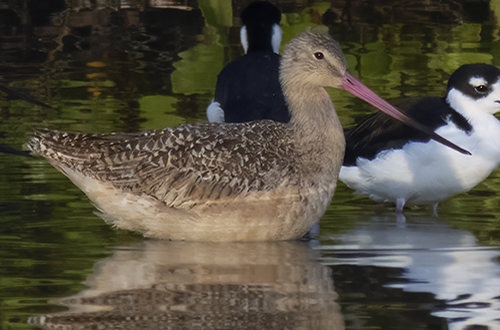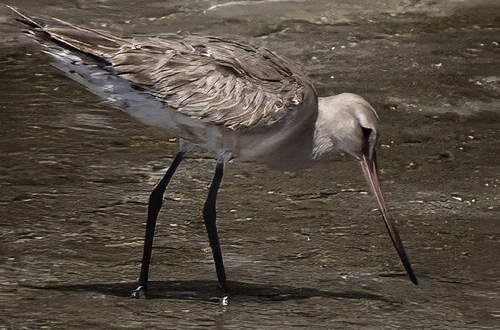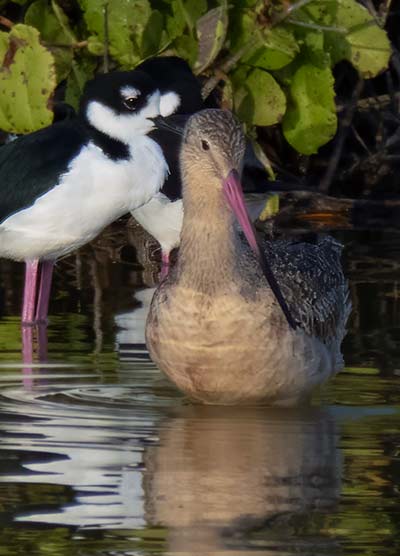A Marbled Godwit Delights Bonaire Birders with a Surprise Visit
A “first” record for the region (the ABC Islands of Aruba, Bonaire, and Curaçao).
Posted April 15, 2024
A Neon Pink Surprise: A Marbled Godwit Visits Bonaire!
While birding recently in the southern salt ponds, a splash of color caught my eye. Tucked amongst the familiar Black-necked Stilts, a large shorebird sported an unmistakable feature – a shockingly pink bill with a black, elongated tip. This wasn’t a bird I had ever encountered before!
Intrigued, my camera clicked away as the bird, cloaked in warm brown and buffy tones with cinnamon underwings, foraged in the shallows. After ten minutes of observation, it took flight, leaving me eager to unravel its identity.
Identifying this mystery bird.
The long, upturned bill suggested a godwit, but it bore dissimilar characteristics to Bonaire’s occasional visitor, the Hudsonian Godwit (Limosa haemastica). Consulting my trusty ABC Islands field guide yielded no answers. I had to delve deeper, poring over broader North American guides, where I found it: The Marbled Godwit (Limosa fedoa), a rare vagrant far from its usual haunts!
The Marbled Godwit’s usual stomping grounds are far from Bonaire’s shores. These impressive birds breed in the shortgrass prairies of central North America, with some populations even nesting as far north as Canada. After raising their young, they embark on a remarkable journey, trading their summer homes for coastal regions in the United States, Mexico, and Central America. This Bonaire visitor is a true adventurer, having strayed far from its typical migration route, making its sighting an exceptional event for birders on the island.
Side-by-side comparison of the Marbled Godwit and Hudsonian Godwit.
While Marbled Godwits and Hudsonian Godwits are both large shorebirds with a trademark long, upturned pink-based bill with a black tip, their plumage and body size offer key distinctions. The Hudsonian Godwit displays a clean, white rump against a black tale and black underwings.
The Marbled Godwit, however, presents a larger and more rounded body, with overall tones that are a warmer brown. Their underwings are cinnamon-colored and the rump and tail are brown.

The Marbled Godwit
The Marbled Godwit shows different field marks from the similar Hudsonian Godwit. Look for the overall warm buffy color, speckled in browns. The underwings are a soft cinnamon color. The rump and uppertail coverts are brown, spotted dull buff and cinnamon.

The Hudsonian Godwit
The Hudsonian Godwit, the smallest of the godwits, is normally observed on Bonaire in its winter plumage when it is an overall plain gray or light brown. Note the white eyebrow and a black underwing, only seen in flight, which are distinctive field marks.
The thrill of observing a first record for Bonaire and for the ABC Islands.
This was, without a doubt, a “lifer” for me – a bird I’d never seen before. Later, a check on the eBird database revealed a remarkable fact: the Marbled Godwit wasn’t just new to me, but to the entire region of Aruba, Curaçao, and Bonaire (the ABC islands). This unexpected visitor is the first of its kind to grace these shores and it officially became bird species #248 for Bonaire!
(Images courtesy of the author.)
Sign up to receive notifications when a new article is posted.
About the author:
 Susan has been living on Bonaire for over 30 years. She is a certified bird guide, as well as a topside and underwater photographer. She is a 2016 graduate of the Caribbean Birding Trail Interpretive Guide Course conducted by BirdsCaribbean.
Susan has been living on Bonaire for over 30 years. She is a certified bird guide, as well as a topside and underwater photographer. She is a 2016 graduate of the Caribbean Birding Trail Interpretive Guide Course conducted by BirdsCaribbean.
Reach out to Susan
Contact Susan via email, Facebook Messenger, give Susan a call, or simply use the online form below.
If you have any questions in regard to your birding tour on Bonaire, feel free to contact Susan to get answers. She is always happy to elaborate on routes or best times for a tour based upon your own personal preferences. Tours can be tailored to your own interests, whether that be birds, photography, or both!
It is also recommended that you do some homework about Bonaire's birds before you visit. By knowing a little bit about the birds which might be encountered on tour, your enjoyment will be heightened! Be sure to check out these resources for Bonaire Birding. Reading the Bonaire Bird Blog will also accustom you to the birds that habitually are encountered on Bonaire.
Facebook Messenger
Get in touch via Facebook Messenger
Telephone
Get In Touch
Get in touch with Susan to check availability for the dates you are visiting Bonaire.
Consent: By using this form you agree with the storage and handling of your data by this website.






